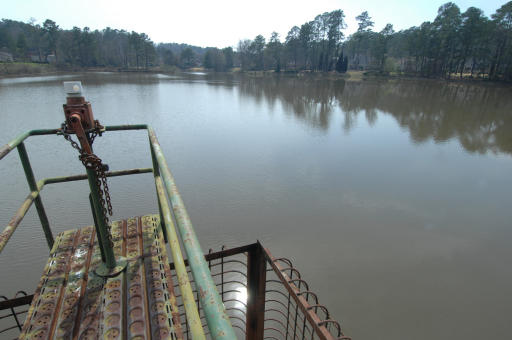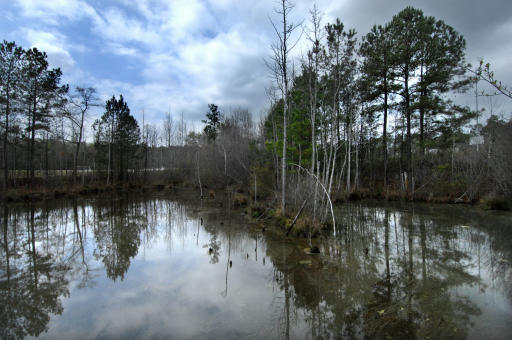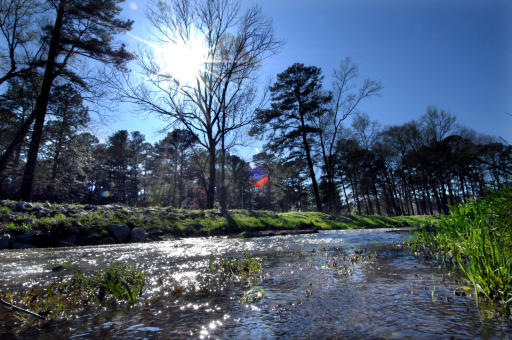Posted February 16, 2012, 4:18 pm
|
Rae's Creek - History runs through it
Rae's Creek's story begins before it flows through Amen Corner
INSIDE THE ROPES
Rae's Creek winds through the National at Amen Corner, the famous stretch of holes that is often instrumental in deciding the Masters winner. The creek flows in front of the 12th green and behind the 11th green. A tributary runs up the left side of the 13th fairway and in front of the greens.
THE UPS AND DOWNS
NO. 11 - WHITE DOGWOOD
Par 4, 505 yards
Lowest Score: 2
Jerry Barber, 1962
Brad Faxon, 2002
K.J. Choi, 2004
Rory Sabbatini, 2006
Stephen Ames, 2008
Drew Kittleson, 2009
Highest Score: 9
Dow Finsterwald, 1952
Bo Wininger, 1958
Griff Moody, 1980
Charles Howell III, 2006
Sandy Lyle, 2017
LARRY MIZE
Mize, a native of Augusta, struck the most memorable shot in Amen Corner's history in 1987.
In a sudden-death playoff with Greg Norman and Seve Ballesteros, Mize was the underdog. Ballesteros was eliminated on the first extra hole, and Mize and Norman headed for the 11th hole.
After Mize missed the green to the right, he left himself a 140-foot shot. He played the chip shot perfectly and the ball rattled the pin and fell into the cup for an improbable birdie, setting off a wild celebration by Mize at Amen Corner.
"I didn't think Larry would get down in two, and I was right,'' Norman said. "He got down in one.''
CHARLES HOWELL
The Augusta native always dreamed of making Masters history, but the nine he carded on the 11th hole in the second round of the 2006 tournament wasn't what he had in mind.
Howell's nine came without the aid of a penalty stroke. His approach found the bunker behind the green, and that's where his troubles began.
It took him four tries to get the ball out of the sand, and then it took him three more shots to get the ball into the cup.
NO. 12 - GOLDEN BELL
Lowest Score: 1
Claude Harmon, 1947
William Hyndman, 1959
Curtis Strange, 1988
Highest Score: 13
Tom Weiskopf, 1980
CLAUDE HARMON
Claude Harmon was the first to make an ace on the 12th in Masters Tournament play.
But his playing partner, Ben Hogan, didn't seem to notice the unusual feat. The stoic Hogan had made a birdie of his own at No. 12.
According to Don Wade's book, Talking On Tour, the exchange went like this:
Hogan: "You know Claude, I can't remember the last time I made a two there. What did you make?"
Harmon: "Why, Ben, I made an ace."
Hogan: "Oh, well, that's great, Claude."
CURTIS STRANGE
Twenty years ago, Curtis Strange made his hole-in-one on the 12th.
But he doesn't have the ball he used in his trophy case.
After retrieving it from the cup, Strange turned and threw it into Rae's Creek.
"There was no real reason why I threw it in the creek," he told reporters. "I just did."
FRED COUPLES:
It's a rite of passage: every Masters champion has to successfully negotiate the tee shot at the 12th if he wants to put on the green jacket.
Couples came to the 12th tee in 1992 with the lead. Every golfer knows that to fire at the pin, tucked in its traditional Sunday placement in the right corner, is folly.
Couples was trying to play it safe, but he blocked his tee shot. It hit the bank on the far side of Rae's Creek and, defying gravity, did not roll back into the water.
From there, Couples chipped up close to save his par and he went on to win by two strokes over close friend and mentor Raymond Floyd.
"The biggest break, probably, of my life," Couples said after slipping into his green jacket. "I'm not so sure what would have happened if it would have went in the water like everybody else's."
TOM WEISKOPF:
Tom Weiskopf has experienced his share of agony at Augusta National. Four times he has been runner-up in the Masters.
But in the first round of the 1980 tournament, Weiskopf experienced a different kind of pain at the par-3 12th.
He found Rae's Creek five times en route to a 13, which still remains as the highest score ever taken on a hole in Masters play.
Weiskopf's 7-iron tee shot spun back into Rae's Creek. From there he went to the drop area and dumped four more balls into the water.
His 11th shot cleared the trouble and went to the back edge of the green, and from there Weiskopf took two more shots to hole out.
"I had a perfect lie for the second one but it spun back in," Weiskopf told reporters after the round. "I should have gone back 50 yards. There was no grass there (drop area), none You can't hit it out of holes, fellows."
Weiskopf went on to shoot 85 in that round, then followed up with 79 to miss the cut.
"I'm extremely embarrassed. I've never been so disappointed," he said. "But I'll be there to tee off tomorrow."
NO. 13 - AZALEA
Jeff Maggert. 1994
Highest Score: 13
Tommy Nakajima, 1978
JEFF MAGGERT:
A double eagle is the rarest shot in golf, and that is no exception at the Masters.
Only three have been made in tournament play, and the last came in the final round of 1994 when Jeff Maggert made one on the par-5 13th.
Maggert's 3-iron shot from 222 yards found the cup and put him in exclusive company with Gene Sarazen (1935, No. 15) and Bruce Devlin (1967, No. 8).
"1 was pretty lucky that it went in," Maggert told reporters. "It was going pretty fast when it hit the pin. It hit the pin and went straight down in the cup.
"Everybody started yelling and screaming. I felt like I was in the lead or something."
TOMMY NAKAJIMA:
The 13th hole has given up plenty of memorable eagles through the years. It has been one of the most pivotal holes in tournament history.
Japan's Tommy Nakajima had a memorable experience on the hole known as Azalea in 1978, but it's one he'd like to forget.
The young pro's misery began when he pulled his tee shot into the tributary of Rae's Creek left of the fairway. He took a penalty drop and laid up in the fairway. Then, his fourth shot came up short and found the creek that guards the green.
According to reports in The Chronicle, he tried to play it out of the water, but the ball bounced off his shoe, costing him a two-shot penalty.
Then he tried to hand his club to his caddie but the sand wedge touched the water, and that was another two-shot penalty.
He finally hit it out of the creek and over the green. From there, he chipped on and two-putted for his 13.
An interpreter who handled the exchange between Nakajima and reporters said the golfer "lost count."
"I promised myself to make an eagle but 1 tried too hard, so I messed up," Nakajima told reporters.
-John Boyette, Sports Editor
OUTSIDE THE ROPES
The creek that becomes famous in the golf world every April has been an integral part of Augusta for centuries. Its story begins a few miles above Amen Corner, flows through the National and runs into the Savannah River.
CHARTING ITS COURSE
Named for an Irishman who prospered as a Colonial trader, Rae's Creek has wielded much influence on Augusta's history, commerce and culture. Today, after countless changes, it remains a map to the area's past.
West of Augusta, just inside the Columbia Coutny line behind Dayspring Church off Frontage Road, water seeps from subterranean rock to form the headwaters. The creek then flows into a wetlands area.
Wrightsboro Road and Rae's Creek intersect two times.
Behind Augusta West Parkway's shopping centers, the creek hides the remains of a gristmill that thrived from the 1920s and into the early 1900s. It was built by William McGarr and offered farmers a place to grind corn into meal.
Near the juncture of Wheeler Road and Camelia Road, the remains are still visible of the largest dam ever built on the creek. A 40-acre lake was formed in 1925 by Levingston Skinner, who operated a sawmill there. Floods destroyed the dams, and the area returned to its natural state.
Just above where the creek crosses Jackson Road, a water-powered mill operated by William Jackson thrived from 1905 to 1915. This mill had an interesting feature: an electric generator that provided electricity for the Jackson household.
The only surviving millpond on Rae's Creek is 10-acre Lake Aumond off Walton Way Extension. The Aumond Corp. bought the land along Rae's Creek at Walton Way in 1912 for ventures that included residential development. Mrs. George Wheeler won a contest naming the corporation, combining "Augusta" and "Richmond County."
In 1836, a geologic survey noted a slender vein of gold that bisectred Rae's Creek near Skinner Mill and ran southwest toward Belair Road. Treasure hunters panned for gold near Wheeler Road. During the course's construction in 1931, workers found small amounts of gold along Rae's Creek.
The Central Savannah River Land Trust protects land along Rae's Creek near the intersection of Aumond Road and Berckmans Road.
The Elevation: At Augusta National, the lowest elevation is 160 feet above sea level - where Rae's Creek flows over the dam at Amen Corner. The highest elevation at the course is 335 feet above sea level, along Washington Road.
Before flowing into Lake Olmstead, the city's 81-acre impoundment off Broad Street, Rae's Creek runs under Calhoun Expressway.
The end of the line: The original length of Rae's Creek was 10.7 miles, ending at the Savannah River after flowing through Lake Olmstead and through an aqueduct beneath the Augusta Canal. In 1873, the aqueduct was closed and the creek flowed directly into the canal, which runs into downtown Augusta and dissipates into the canal's urban levels.
THE NAME
Irishman John Rae came to Augusta in 1734 and lived just southeast of the creek's confluence with the Savannah River. In 1765, he established a grist mill nearby, and from 1763 onward, Georgia maps designate the waterway as "Rae's Creek." His fortresslike home occupied a bluff near the river, from which he also operated a ferry. At one time he owned more than 8,000 acres. He died in 1789.
THE TREASURES
The creek banks, particularly along the Fault Line and into the plateaus within the National's property on the channel's north side, are littered with stone projectile points and other artifacts from Native American settlements dating from 3,000 to more than 10,000 years ago.
Rae's Creek has 74 tributary streams, and its basin includes - or has included - 110 man-made dams.
The waters harbor 35 species of fish. Plant life is plentiful along the banks: redbay, water oak, flowering magnolia, dogwoods, heartleaf wild ginger and round-lobed hepaticas.
One of the creek's most beautiful plants, the Royal Fern, can be found in damp, shaded areas along its banks, nestled among loblolly pines, Southern lady ferns and Chinese privet.
THE HISTORY
Michael C. White has studied Rae's Creek more than anyone. White is an Augusta author who often worked as a reserch assistant with the late Dr. Ed Cashin on books designed to preserve local history. As a high school senior at Richmond Academy, White decided there was ample history flowing along the creek to write a book.
-Rob Pavey, Staff Writer


















 Abraham Ancer
Abraham Ancer
 Daniel Berger
Daniel Berger
 Christiaan Bezuidenhout
Christiaan Bezuidenhout
 Patrick Cantlay
Patrick Cantlay
 Paul Casey
Paul Casey
 Cameron Champ
Cameron Champ
 Stewart Cink
Stewart Cink
 Corey Conners
Corey Conners
 Fred Couples
Fred Couples
 Jason Day
Jason Day
 Bryson DeChambeau
Bryson DeChambeau
 Harris English
Harris English
 Tony Finau
Tony Finau
 Matthew Fitzpatrick
Matthew Fitzpatrick
 Tommy Fleetwood
Tommy Fleetwood
 Dylan Frittelli
Dylan Frittelli
 Sergio Garcia
Sergio Garcia
 Brian Gay
Brian Gay
 Lanto Griffin
Lanto Griffin
 Brian Harman
Brian Harman
 Tyrrell Hatton
Tyrrell Hatton
 Jim Herman
Jim Herman
 Max Homa
Max Homa
 Billy Horschel
Billy Horschel
 Viktor Hovland
Viktor Hovland
 Mackenzie Hughes
Mackenzie Hughes
 Sungjae Im
Sungjae Im
 Zach Johnson
Zach Johnson
 Dustin Johnson
Dustin Johnson
 Matt Jones
Matt Jones
 Si Woo Kim
Si Woo Kim
 Kevin Kisner
Kevin Kisner
 Brooks Koepka
Brooks Koepka
 Jason Kokrak
Jason Kokrak
 Matt Kuchar
Matt Kuchar
 Martin Laird
Martin Laird
 Bernhard Langer
Bernhard Langer
 Marc Leishman
Marc Leishman
 Joe Long
Joe Long
 Shane Lowry
Shane Lowry
 Sandy Lyle
Sandy Lyle
 Robert MacIntyre
Robert MacIntyre
 Hideki Matsuyama
Hideki Matsuyama
 Rory McIlroy
Rory McIlroy
 Phil Mickelson
Phil Mickelson
 Larry Mize
Larry Mize
 Francesco Molinari
Francesco Molinari
 Collin Morikawa
Collin Morikawa
 Sebastian Munoz
Sebastian Munoz
 Kevin Na
Kevin Na
 Joaquin Niemann
Joaquin Niemann
 Jose Maria Olazabal
Jose Maria Olazabal
 Louis Oosthuizen
Louis Oosthuizen
 Carlos Ortiz
Carlos Ortiz
 Charles Osborne
Charles Osborne
 Ryan Palmer
Ryan Palmer
 C.T. Pan
C.T. Pan
 Victor Perez
Victor Perez
 Ian Poulter
Ian Poulter
 Jon Rahm
Jon Rahm
 Patrick Reed
Patrick Reed
 Justin Rose
Justin Rose
 Xander Schauffele
Xander Schauffele
 Scottie Scheffler
Scottie Scheffler
 Charl Schwartzel
Charl Schwartzel
 Adam Scott
Adam Scott
 Webb Simpson
Webb Simpson
 Vijay Singh
Vijay Singh
 Cameron Smith
Cameron Smith
 Jordan Spieth
Jordan Spieth
 Henrik Stenson
Henrik Stenson
 Tyler Strafaci
Tyler Strafaci
 Robert Streb
Robert Streb
 Hudson Swafford
Hudson Swafford
 Justin Thomas
Justin Thomas
 Michael Thompson
Michael Thompson
 Brendon Todd
Brendon Todd
 Jimmy Walker
Jimmy Walker
 Matt Wallace
Matt Wallace
 Bubba Watson
Bubba Watson
 Mike Weir
Mike Weir
 Lee Westwood
Lee Westwood
 Bernd Wiesberger
Bernd Wiesberger
 Danny Willett
Danny Willett
 Matthew Wolff
Matthew Wolff
 Gary Woodland
Gary Woodland
 Ian Woosnam
Ian Woosnam
 Will Zalatoris
Will Zalatoris